Children are helped to study and perceive object forms by their geometric figuresThe appearance of such figurative examples for preschoolers should be three-dimensional for better perception.
How preschoolers of different ages perceive geometric shapes
From the age of one and a half, children can visually distinguish between known figures and classify objects by shape. By the age of two, they show the ability to find certain shapes among other geometric bodies. From the age of three, the child is already able to name them.
Four-year-olds compare three-dimensional and flat figures, while older children analyze complex illustrations with a large number of such displays. From the age of 5 and later, children can be introduced to geometric bodies. From birth, observing phenomena and objects, children learn about the world around them. Visual-sensory learning occurs.
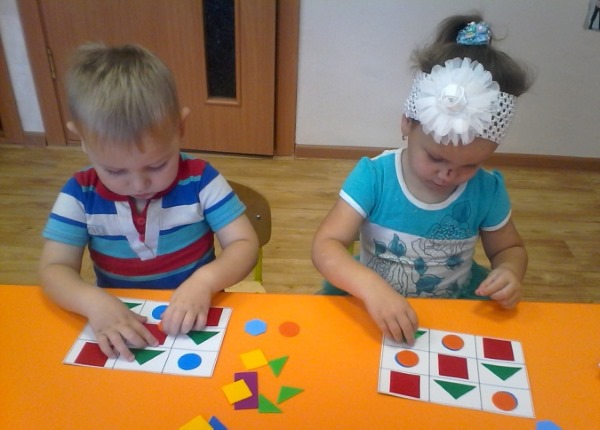
By becoming familiar with geometric shapes, children acquire additional skills:
- generalizations;
- analysis;
- comparisons;
- orientation in space;
- speeches.
Learning geometric shapes: names, shapes, colors, sizes
Children are introduced to simple shapes and their colors from the age of 2 to 3. The training should be unobtrusive, in the form of a story or entertainment.
The following may come to your aid:
- sorter;
- toys with wooden inserts;
- pictures.
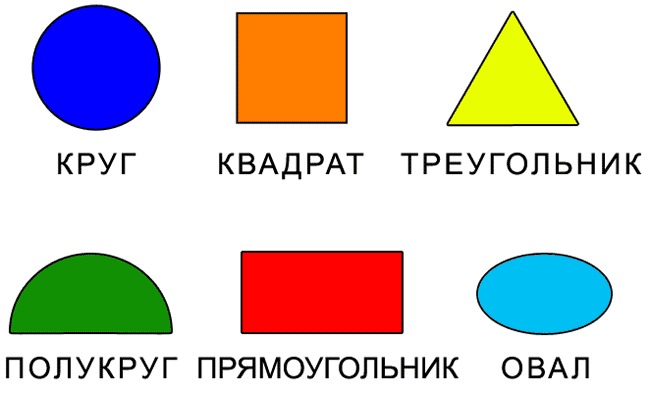
From the age of 2, children should know colors and geometric shapes such as:
- white;
- green;
- yellow;
- red;
- blue;
- pink;
- black;
- violet;
- orange;
- circle;
- square;
- triangle;
- oval;
- rectangle;
- semicircle.
Three-dimensional geometric figures can and should be studied in a playful way to arouse children's interest. After all, the entertaining moment of familiarization with various forms significantly facilitates the entire subsequent educational process. At the same time, children learn to focus only on what is necessary and to show independence.
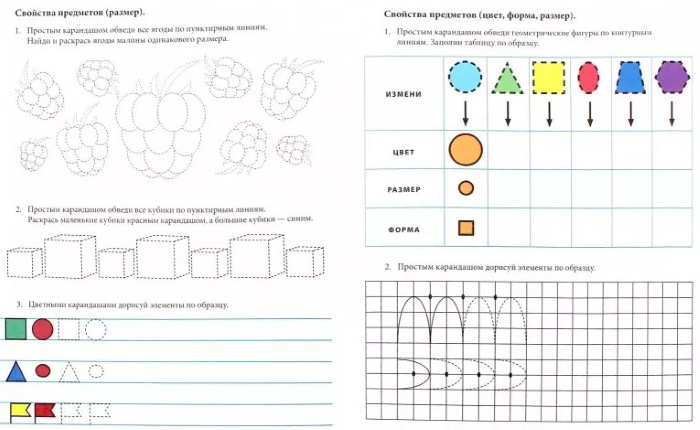
The chronology of teaching preschoolers simple descriptive geometry will be as follows:
- different figures depicted on thick paper, differing in color and size, are named and spoken out together with the child;
- tracing the outlines of figures on cardboard and then coloring them in certain colors, comparing the sizes of images;
- The cut-out figures are placed in different places around the house so that children can later find them and name them, also saying their size and color;
- an offer to play with different mosaics and pyramids made of geometric shapes;
- identification with other objects in the environment.
There are plenty of ways to study geometric figures, among them the following stand out:
- observing when children are introduced to cardboard cut-out shapes and then asked about them;
- comparative, in which preschoolers look at paired cards with figures and note their differences and similarities;
- reinforcement, consisting of asking children about the material they have covered.
Learning complex geometric shapes with simple ones
Three-dimensional geometric figures made of paper are components of various methods for introducing children to the basics of mathematical knowledge.
They are used to teach preschoolers of all ages. Classes with formal examples of objects are always held in an entertaining and educational way.
Compound geometric figures are made up of simple ones, for example:
- trapezoid of 2 triangles and squares;
- a parallelogram of two identical triangles and the same number of squares;
- rhombus made of 2 identical triangles;
- a rectangle made of several squares.
Descriptive Geometry Lessons for Kids
Introduction to descriptive geometry develops spatial thinking in children. Exercises in such a difficult graphic discipline must be understandable and as simple as possible.
In the educational process of teaching the basic principles of geometry before school, the following tasks are often used:
- children are given posters with tables of square cells, according to which they must determine and compare the sizes of figures;
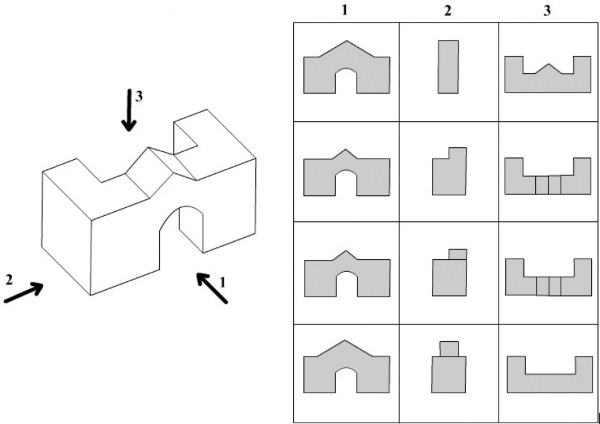
- looking at visual materials with images of insects made up of various figures, the child should tell which of them are longer or shorter;
- dividing drawn shapes into groups;
- mastering the connections between shapes and numbers by counting shapes and solving simple problems;
- drawing figures on sheets of paper in a grid according to the proposed parameters;
- mastering the concepts of bigger-smaller, shorter-longer by using paper strips of different lengths to measure chains with figures;
- finding drawings containing geometric figures;
- counting shapes in the given images;
- drawing composite figures from simple pairs;
- listing the forms that are present in the proposed items;
- familiarization and memorization of figures drawn on posters;
- tracing using stencils;
- games with images of different shapes;
- finding extra samples among identical figures;
- sorting forms into groups;
- games with construction sets or cubes;
- drawing with crayons or on sand;
- laying out figures from chestnuts or acorns in the sandbox;
- comparison of simple and three-dimensional figures with the presented examples;
- finding composite shapes in flat images;
- reproduction of geometric figures by means of modeling or drawing;
- cutting out shapes and then gluing them to the base.
- analysis of images with complex shapes, recognition of their constituent parts.
After the children have fully mastered all the basic figures, it is recommended to constantly repeat and pronounce them for better consolidation and memorization.
Finishing drawing a flat figure using a sample
Developmental tasks for finishing drawing geometric figures help to remember them faster. In the exercise form, the child must complete the picture using a pencil and a ruler.
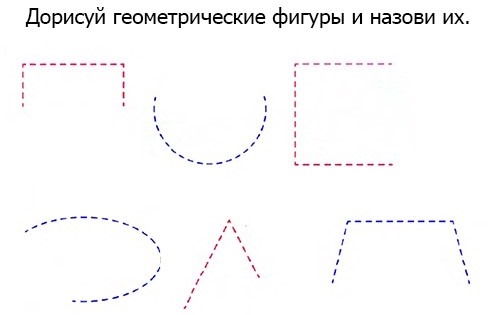
During the lesson:
- The children are shown figures and told about them. Then examples of similar objects in the room are given.
- Print out forms with unfinished figures. The outlines of the images should be dotted.
- Say the task: circle the dots and complete the figures. Explain what each of them is.
- Discuss the results of the work with the children.
Along with the incompleteness of the figure, you can supplement it with partial coloring. After finishing the drawing, the child can be asked to completely finish it with color.
Tracing a figure by points
To develop imagination, children should trace the images of figures by dots. This also forms a useful ability to implement exercises according to a model. Children should do the outlining with a simple pencil, so that it will be easier to correct the shortcomings with an eraser.


Algorithm for the lesson on tracing figures by points:
- Distribute printed forms with examples of the drawing and its dotted images.
- Ask children to connect all the dots correctly.
- Compare the result with the sample.
Find geometric shapes in an image
Descriptive geometry figures are very attractive to children. They are always interested in how to break down complex images into simple ones and then transform them back.
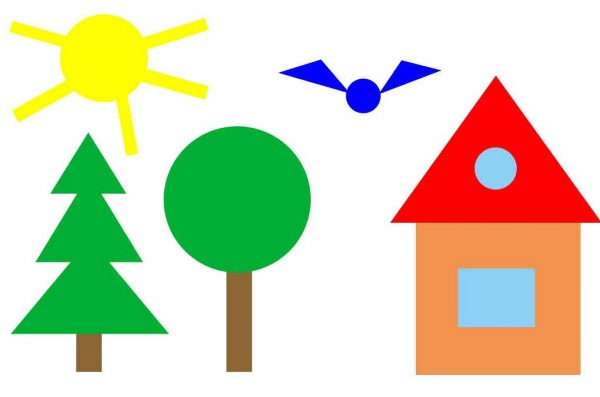
Tasks for finding geometric figures can consist of:
- rhombuses;
- ovals;
- trapezium;
- rectangles;
- triangles;
- squares;
- circles.
Coloring
The exercise of coloring overlapping figures ultimately develops spatial thinking in children.
Example of conducting a lesson:
- Different figures with intersecting ends are drawn on sheets of paper.
- Children are given colored pencils and pictures.
- Next, each child must complete the coloring of the figures.

Geometric images of objects teach preschoolers to correctly perceive the shape of objects around them. It has been scientifically noted that children can distinguish shapes as early as 3 months. The volume of such samples helps older children identify them with similar objects.
Putting together geometric shapes from puzzles
For better assimilation of geometric figures, children are offered to assemble special puzzles. The exercises should be simple at first, and then they are gradually complicated. With the completion of such tasks, imagination develops, and children learn to understand how figures lie relative to the plane.

Example of a jigsaw puzzle assembly lesson:
- Make forms with two rows, one of which depicts simple figures, and the other – complex ones.
- Ask the children to find in the lower images those that contain the upper ones.
- Explain the result to each child.
Grouping simple shapes into complex ones
The exercise is performed as follows:
- Simple figures printed or drawn on cardboard are cut out.
- Children need to create more complex shapes from the provided blanks.
- To memorize numbers, you can count each type of figure.
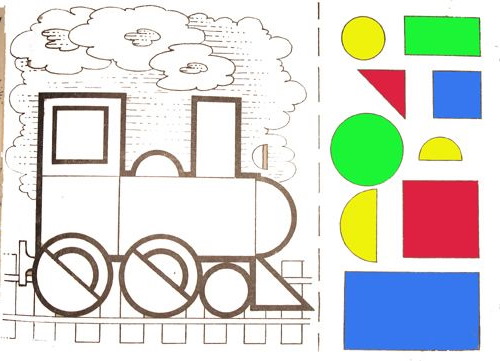
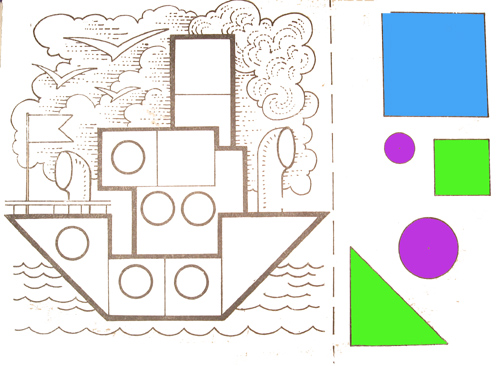
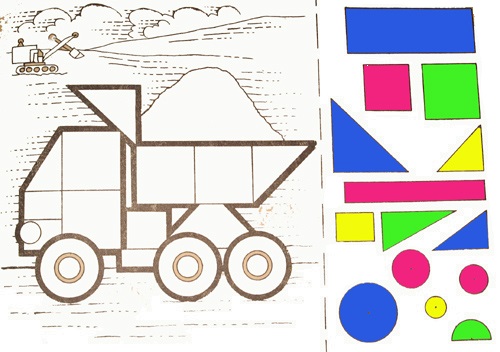
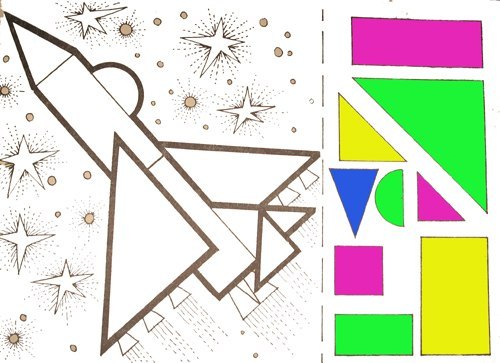
To make the task more difficult, children are asked to assemble whole images from ready-made templates, for example, an airplane or an animal.
Geometric Appliques: Step-by-Step Instructions for Preschoolers
For different ages of preschoolers, creating appliques from figures differs from each other:
- Until the child reaches 5 years of age, adults do the paper cutting, but gluing the figures can be entrusted to children.
- Until the age of five, children will have to be corrected by their parents or caregivers if they cut out parts unevenly.
- A child who has turned 5 years old can only be observed.
Younger preschoolers always simplify the shapes they see. For example, they depict fluffy clouds as ordinary ovals.
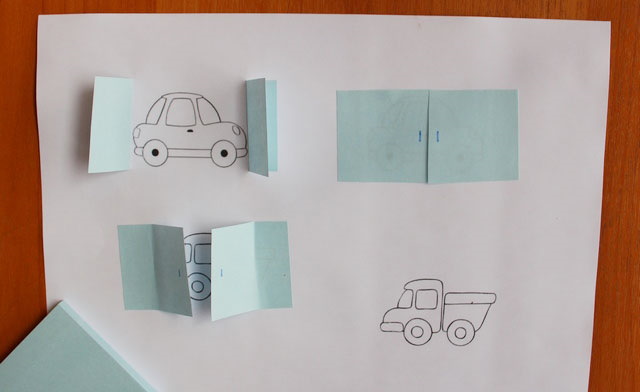
Three-dimensional geometric figures, as well as simple ones, are suitable for appliques if they are paper. They are easy to form into groups, creating even more complex bodies, and then glue to cardboard. After that, such crafts become a visual aid for further training.
For the Garage applique, children must draw it on paper, and they can be asked to do:
- square doors;
- triangular roof;
- arched gate.
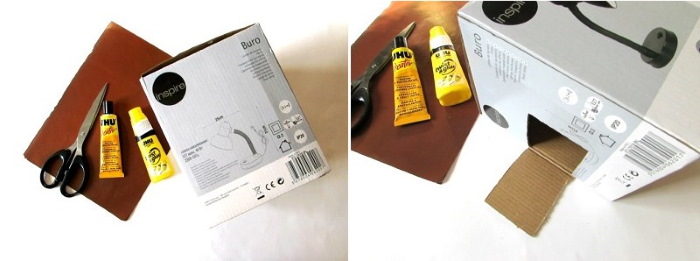
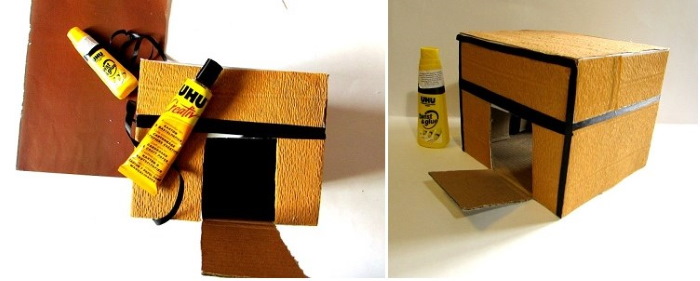
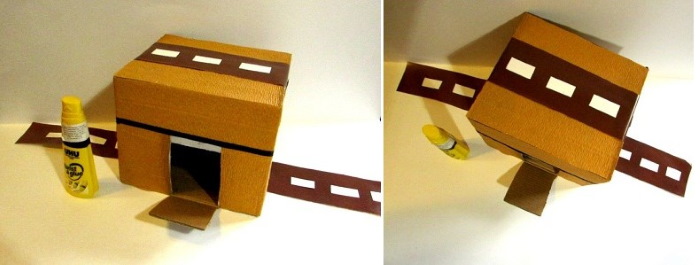
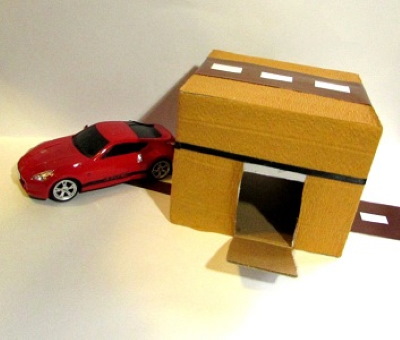
Then preschoolers should cut out the garage parts and glue them to the cardboard. Then they can build a car in the same way, which must be placed in the finished garage after that.
To create an Animal applique with your child, you need to cut out samples of small animal parts.
So, the following are suitable for a cat:
- circles instead of eyes;
- ovals for the head and body;
- triangles for ears.

The preschooler will then assemble the templates prepared by the adult into a cat shape and glue them onto the base. The result should be a paper composition on the theme of an animal with glued geometric figures as applique details. Young children, playing with shaped templates, develop their creativity and fine motor skills.
Samples for applications are required:
- form into a color sketch;
- add according to the given example;
- stick to a given surface.
To create paper compositions from geometric shapes you will also need:
- consumables for applications;
- glue stick;
- base for the foundation in the form of a wooden block or cardboard;
- Convenient children's scissors with blunt ends.

Before applique classes for children, their work places are carefully prepared:
- check surfaces for safety;
- remove all objects that distract from work;
- cover the table with newspapers or oilcloth;
- eliminate everything that can cause discomfort during the work process;
- provide the workplace with additional tools.
When creating applications, children learn:
- be careful and diligent;
- recognize geometric shapes;
- think creatively;
- interact with the team;
- the basics of design;
- painstaking work.
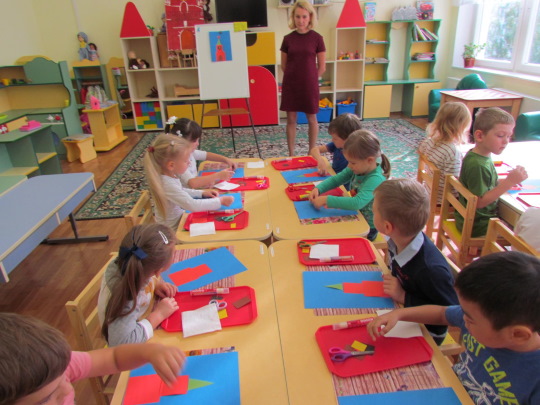
When doing joint exercises with a preschooler, adults will have to:
- organize everything correctly;
- conduct classes in a playful manner to maintain children's interest;
- to develop tactile perception, use various materials;
- select a topic for a specific child's age;
- let the child speak out and analyze his mistakes with him;
- stimulate children's imagination and independence.
Introduction to three-dimensional and flat geometric figures made of paper in games
Three-dimensional geometric figures are very convenient to remember using the analogy method with surrounding objects. With their help, preschoolers study the world around them. Games with spatial geometric bodies form future mathematical concepts in children.
For games with different geometric shapes, you can make your own paper templates from cardboard.
It will be very convenient and interesting for children to play with such figures, as well as to construct all sorts of structures and crafts.
By playing with geometric shapes, children learn:
- comparison of different shapes with geometric patterns;
- finding three-dimensional figures from flat samples;
- reproduction of geometric bodies;
- analysis of complex forms and their reconstruction from simple ones.
The essence of the educational game Magic Bag is that children are asked to find in a small bag first certain figures according to a volumetric or flat sample, and then objects similar to them.
For the universal game Geometric Lotto you will need 2 copies of cards made by yourself. Figures are drawn on them. One copy is cut into separate cards, and the second is left whole.
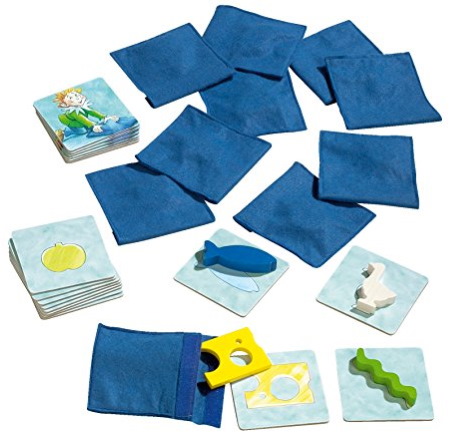
At first, it is necessary that all the figures are the same size and color. After children have mastered them, the shapes are made different. Preschoolers after 3 years old are offered large cards with objects of different shapes. After the leader announces a geometric figure, children find a card with an object corresponding to it.
Children can also be asked to divide geometric shapes of different types between dolls, like cookies. For the game, 2 types of shapes are taken at once, and later 3. So, for example, the child will need to give one doll a square cookie, and the second - a round one.
The following can also help you learn the basics of geometry:
- educational cartoons:
- active games;
- guessing shapes by touch;
- lacing;
- mosaics;
- counting sticks;
- stencils;
- modeling and drawing;
- frames with inserts and sorters.
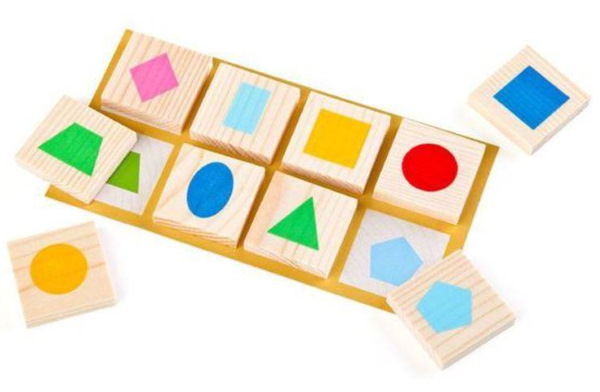
By getting acquainted with geometric shapes in an easy, playful way, children:
- gradually get used to mathematics;
- master the main principles of activity;
- demonstrate independence and initiative;
- acquire the ability to choose activities;
- learn to negotiate taking into account the feelings and interests of the interlocutor;
- begin to empathize better with others.
Exercises with figures that introduce preschool children to their properties are excellent for broadening their horizons. Transforming simple shapes into more complex and voluminous ones develops spatial understanding and geometric thinking. In addition, children learn to be persistent and goal-oriented in such classes.
Author: tanyda
Video about geometric shapes
Geometric figures made of paper (volumetric and flat):
